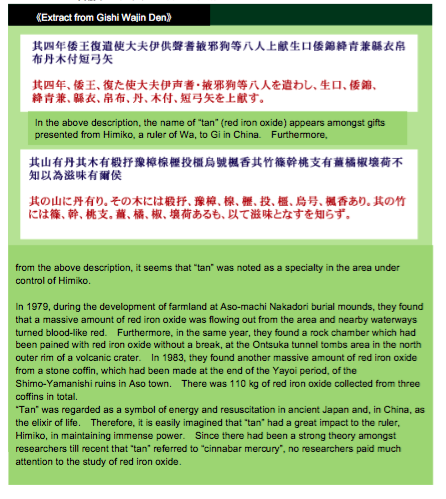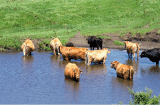>>Japanese
Once upon a time, there used to be a woman who had been deeply attracted to the beauty of “Aso yellow ocher (limonite)”. Her name was “Himiko”, a queen of Yamatai-koku (an ancient regional queendom, Yamatai). A record remained says that Himiko, the queen of the country, Wa (the ancient name of Japan), sent gifts to the country called Gi (a kingdom in ancient China) and the word, “tan”, appears repeatedly in the list of the gifts. “Tan” represents red iron oxide, which people in Wa widely used in various occasions, such as “when giving gifts to someone superior”, “in magic rituals” and “as a decoration in everyday life”. Whereas, it is believed that, in ancient China, people treasured “tan” as “the elixir of life”.
Time flied. In around 1979, a massive quantity of red iron oxide was discovered from stone chambers and stone coffins inside ancient tombs of the Yayoi period which existed in the Aso area. How on earth did ancient people manage to obtain red iron oxide in such huge quantities? The answer is that it came from the blessing of nature, “Aso yellow ocher (limonite)”. When limonite is heated, the colour of its main component, iron, turns to rich dark reddish-brown. In the Aso area, people used limonite to paint buildings and gateways at the entrance to Shinto shrines because it had antiseptic and bactericidal effects.
Some people advance the theory that all these points, ie, “the likely location of Yamatai-koku in Kyushu Island and contents in Gishi Wajin Den (a historical record written in Gi about Japanese people from Yamatai-koku)”, “red iron oxide found from ancient tombs of the Yayoi period” and “limonite” are closely connected each other. And, even now after a long time has passed, people treasure “limonite” as “the blessing of nature” and “the earth for the life”.


It is said that the name of an area, “Akamizu” (meaning Red Water), where limonite has been mined, came from the colour of water which had contained plenty of iron hydroxide. The water was seeping out to gutters and swamps and eventually came under people’s observation. Even nowadays, we can see some iron stuck to irrigation canals and rice fields.

According to our information, cattle farmers used to come to our factory based in Kario, Aso, to get yellow ocher. It was because they knew that limonite had an effect as anti-diarrheal agent for cattle. The main component of limonite is ferrous oxide, which exists in quite unstable state by itself. That unstable molecule tries to be coupled with other molecules to become stable. This feature represents another power of limonite, ie, “adsorption”. This adsorption power shows an amazing effect inside animal body system, in the air and in the water.
Also, because limonite is rich in iron and other multi-minerals, it has been used as feed for pig breeding across Japan and showing its effects in maintaining health and improving the meat quality of pigs nowadays.